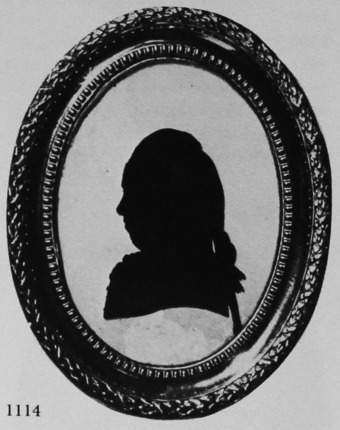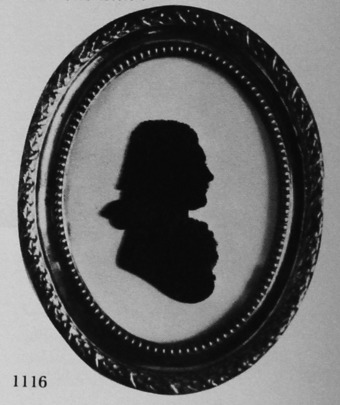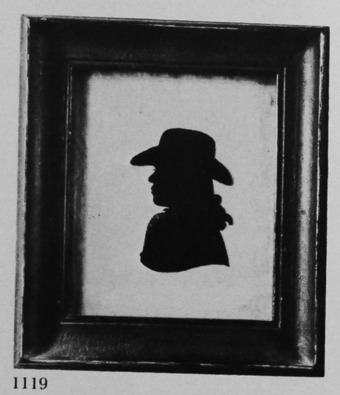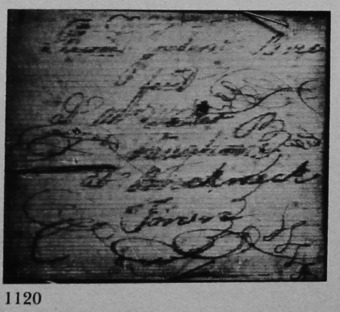Jorden, Richard (McKechnie Section 3)
See also Walter Jorden and the entry on Richard Jorden in Section Two
The available information about Richard Jorden's life, biographical evidence provided by his work, and the technical and stylistic attributes which he shared in his work with his brother Walter Jorden, are discussed in the entry on the latter. The present entry is confined to a detailed account of the silhouettes which can be ascribed to Richard Jorden, and of his known inscriptions.
Two silhouettes which I have seen, signed Richard Jorden, in an unmistakably contemporary hand, have made it possible to isolate this artist's work on glass with certainty for the first time. One of these silhouettes is dated 1782. The portraits of the Deverell family are so similar in style that these must also be the work of Richard Jorden. No example has been seen showing the use either of a needle, or of a quill, such as appears to have been used by Walter Jorden.
Of the silhouettes with which I have illustrated the present entry, the example signed and dated 1782 is painted in severe black. Jorden made little attempt to show the shaping of the wig on this example (or on his other silhouettes of men), apart from the slight suggestion of the raised toupée. Buttons on men's coats are very small; shirt-frills are shown with no transparency, being indicated only with a scalloped line.
1114
Bust-lines show a simple concavity/convexity line; by 1783 Jorden made them slightly more rounded towards the front. Some primitive transparency is used to indicate feathers on Elizabeth Deverell's hat; on the portrait of Hester Deverell a trace of blotchy transparency is used to indicate a handkerchief or frill at her neck. This feature is more evident on the three profiles, probably painted as late as 1785, in the Christie collection.
The transparency shown on the three latest illustrated examples, indicating frills on two profiles of men and on one profile of a woman, is marked by a strong black line; the space between this and the solid black of the profile is filled by smudged pigment carefully graded in varying depths in order to give the effect of a pattern. Seen out of context, this effect would hardly suggest the pattern of a shirt-frill; but the style, which has not been seen on earlier work, is distinctive, and would be readily identifiable on other examples. On the portrait of the woman in this group of three painted at Brecon, feathers are painted in a more finished style than are those on the profile of Elizabeth Deverell. These silhouettes lack a glass backing, though this may originally have been present.
Earlier work is housed in oval hammered brass frames. The Brecon group are in rectangular gilt frames, as are the silhouettes painted on rectangular pieces of glass. The Deverell portraits are framed together in a mount showing the portraits in hexagonal shapes.
Two inscriptions of Richard Jorden are known. One (illustrated 1120), on the reverse of one of the three silhouettes taken at Brecon, establishes the attribution to Jorden of the other two, taken at the same time (c. 1785) and manifestly from the same hand. Written, probably with a quill, on wood, and adorned by many scrolls and scribbles, it can be deciphered as follows:
Richard Jorden Breco[n]
fecit
at Mrs. Walter
Vaughan['s]
at Brecknock
Forum.
Another silhouette bears an inscription, written on the wooden backing of the frame in script: 'Richd Jorden fecit 1782.'
Ills. 1114-1119

Unknown man
Silhouette painted on flat glass, backed with a second piece of glass coated with gesso
1782
3¾ x 2¾in./96 x 70mm.
Frame: oval, hammered brass
This silhouette can be regarded as a basis for identifying Jorden’s early work on glass. Inscribed on the reverse, ‘Richd Jorden fecit 1782’.
Mr and Mrs J. H. Gutteridge collection

Members of the Deverell family
Six silhouettes painted on flat glass, mounted together
1783
Attributed by Jackson to ‘William Jorden’ (see entry on Walter Jorden), the name with which these silhouettes are inscribed. Elizabeth was presumably Thomas Deverell’s wife; Caroline possibly her sister.
From E. Nevill Jackson, ‘The History of Silhouettes’ (1911), by courtesy of the ‘Connoisseur’

Unknown man
Silhouette painted on flat glass, backed with a second piece of glass coated with gesso
c. 1783-84
3¾ x 2¾in./96 x 70mm.
Frame: oval, hammered brass
Author’s collection

Unknown woman
Silhouette painted on flat glass
c. 1785
3½ x 2 7/8 in./90 x 74mm.
Frame: rectangular, giltwood
Taken at Brecon, this silhouette bears on the reverse the illustrated inscription (1120) of the artist, and therefore provides evidence for the identification of the silhouettes illustrated in 1118 and 1119.
M. A. H. Christie collection

Unknown man
Silhouette painted on flat glass
c. 1785
3½ x 2 7/8 in./90 x 74mm.
Frame: rectangular, giltwood
Taken at Brecon; unsigned.
M. A. H. Christie collection

Walter Vaughan
Silhouette painted on flat glass
c. 1785
3½ x 2 7/8 in./90 x 74mm.
Frame: rectangular, giltwood
Taken at Brecon; inscribed with the sitter’s name on the reverse.
M. A. H. Christie collection

Inscription on the reverse of a silhouette (1117) by Richard Jorden.
M. A. H. Christie collection
